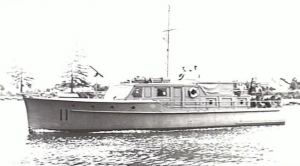HMAS Leilani
| Type |
Motor Yacht |
|---|---|
| Pennant |
11 |
| Builder |
WL Holmes & Co, Sydney NSW |
| Commissioned |
21 July 1941 |
| Decommissioned |
19 November 1945 |
| Dimensions & Displacement | |
| Length | 55 feet |
| Beam | 14 feet |
| Draught | 4 feet 3 inches |
| Performance | |
| Speed | 14.5 knots |
| Armament | |
| Guns | 1 x .303 inch Vickers machine gun |
| Other Armament | 2 x Mk VII depth charges, 1 x PAC projector |
Leilani was constructed by WL Holmes & Co Boatyard at McMahons Point in Sydney and launched in March 1936 as MY Dawn for George Raymond Vaughan of Camperdown, a member and future vice-commodore of the Royal Motor Yacht Club of NSW in Rose Bay. She was re-named Leilani sometime after May 1937.
She was requisitioned by the Navy on 18 June 1941 and commissioned as HMAS Leilani on 21 July 1941 as a tender to HMAS Penguin under command of Warrant Officer John Gault, RANR(S). She was purchased outright by the Navy, via an impressment order, on 12 November 1942. She was armed with one .303 Vickers machine gun mounted aft with depth charges at the stern.
Leilani was initially employed as a channel patrol boat at Sydney, Port Kembla and Newcastle. Coastal patrol operations were an important, although thankless and often fruitless, task. The submarine threat off the east coast of Australia, however, demanded that such patrol operations be conducted. Two submarine sightings off Port Kembla on 14 and 15 April 1943 saw Leilani participating in anti-submarine sweeps in the area, and indeed HMAS Mischief dropped a depth charge after a possible sighting on the 15th though it failed to detonate, but no further trace of a submarine could be found.
Leilani was fitted with new twin Ford V8 Vosper conversion engines in 1944 and on 8 November 1944, in company with HMAS Three Cheers, she departed Sydney for Madang in New Guinea. Travelling via Newcastle, from where they were joined by the 38ft Army fast supply vessel AM 1496, the voyage was to prove problematic. Engine defects in Leilani hampered progress and required attending to in Coffs Harbour causing Three Cheers and AM 1496 to continue on without her.
She arrived in Brisbane in early December where she underwent further defect rectification at the Motor Launch Repair Base. The vessel departed Brisbane on 10 December but returned when her Commanding Officer, Sub Lieutenant Edward Wedderspoon, RANVR, believed that she had struck a submerged object near the mouth of the Brisbane River. She was slipped on the 12th but was found to be undamaged. She was to depart later that day for Gladstone and then Townsville.
On 21 December, with Leilani two days overdue at Townsville, the No. 1 Flying Boat Maintenance Unit at Bowen conducted a search for her after initial reports suggested that the patrol boat had been involved in a collision but it was later confirmed that she had run out of fuel. The Flying Boat Unit reported that she reached Bowen under her own power but appeared to have been towed the rest of the way to Townsville.
Leilani remained in Townsville until 19 January 1945 when she was taken in tow by MV Muliama bound for Port Moresby. From there she continued on to Hollandia via Milne Bay, Langemak and Madang, at various times in tow of HMA Ships Cowra and Bowen, as well as under her own power. She arrived at Hollandia on 18 March where she operated as a pilot vessel before proceeding to Morotai in June where she continued to operate for the remainder of the war.
On 29 September Leilani was taken in tow by HMAS Cootamundra, a corvette returning to Australia to pay off. The passage south proved to be yet another difficult one. Inclement weather limited speed to four knots before worsening off the Queensland coast and forcing speed to be reduced to two knots. Even at that speed Leilani was taking on water faster than could be pumped out. This necessitated the two ships to shelter in Refuge Bay during the evening of 19 October before resuming passage in calmer weather on the 21st. After an overnight stay at Brisbane on 24/25 October, Cootamundra and Leilani arrived in Sydney on the 27th. Leilani secured alongside at HMAS Rushcutter.
HMAS Leilani decommissioned on 19 November 1945 and was sold at auction on 16 February 1946.




